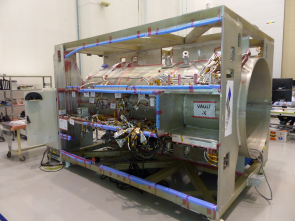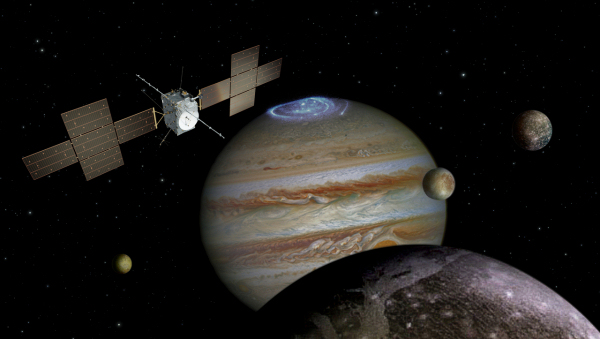Review board gives JUICE the all clear
3 April 2019
ESA's JUpiter ICy moons Explorer, JUICE, has been given the green light for full development after its critical design review was successfully concluded on 4 March. This major milestone marks the beginning of the qualification and production phase, taking this flagship mission one key step closer to starting its long journey to Jupiter in 2022.The critical design review (CDR) was carried out during the period between December 2018 and March 2019, although preparations for this major review began many months earlier.
Around 100 people from ESA were involved in the CDR, including the members of the review board, chairpersons, reviewers, and project team members. The review also required a major effort and investment from all parties involved, including industrial partners.
In preparation for the review, five independent CDRs were held for main JUICE subsystems as well as 14 equipment CDRs, with over 400 documents were delivered to ESA by the start of the review.
Meanwhile, the review teams themselves were divided into dedicated panels that would each focus on specific aspects of the design: mission/system; mechanical/thermal; product assurance/quality/safety; electrical; assembly, integration, and testing; and schedule.
On 4 March, the review board declared the JUICE CDR a success, meaning no obstacle has been identified that should prevent the mission from moving to the qualification and production phase. The review confirmed that the project is under control and that the design as reviewed is expected to meet the science and mission requirements.
"JUICE is half way through its development programme and running precisely on schedule," said Giuseppe Sarri, ESA's JUICE project manager. "The excellent outcome of the critical design review, with a clear and confirmed design, gives confidence that the planned launch date will be met."
After launch, currently planned for 2022, JUICE will embark on a 7.5-year cruise toward Jupiter, entering orbit around the giant planet in 2029 to study its environment and three of its icy moons: Ganymede, Europa and Callisto.
| JUICE's Jovian odyssey. Click here for details and large versions of the video. Credit: ESA |
"The critical design review was a long time in preparation, but the preparation itself proved very useful to consolidate the mission's status after a few years of rapid progress since the preliminary design review," added Robert Furnell, ESA's JUICE system engineering manager.
"The result is evidence that all the teams are working well and that the design is secure. The critical design review was held as planned, almost exactly two years after the preliminary design review, demonstrating that the project remains on course for launch in 2022."
Reviews of the mission's science capabilities were all positive. They found that the communications downlink capability from the spacecraft exceeds requirements. The power and energy available for supporting the payload operations provides sufficient margins for the flybys of Europa in particular.
Overall, the pointing performances of the spacecraft and its trajectory in the Jupiter system also meet the mission requirements. The propellant budget is adequate to perform the required mission.
Furthermore, the primary science operations, which involve a series of Europa flybys and insertion into a 500-km circular orbit around Ganymede, have been validated by industry.
"The critical design review has shown that we are on the right track with this fantastic mission," said Olivier Witasse, ESA's JUICE project scientist. "We are well on the way to developing a spacecraft that will provide the most complete exploration of the Jupiter system, and characterise the subsurface oceans inside the planet's giant icy moons."
 |
| JUICE engineering model. Credit: Airbus Defence and Space |
In the next phase, the JUICE team will start to integrate and test the flight model version of the spacecraft, starting with the structure and chemical propulsion system.
In parallel with integration of the flight model, testing will continue on the electrical and functional engineering model spacecraft mockup in Toulouse, France, which is currently outfitted with key units from the platform and instrument packages.
The next major milestone for JUICE will be the flight acceptance review, currently scheduled for late 2021, which will declare whether the spacecraft is ready for launch.
About JUICE
JUICE (JUpiter ICy moons Explorer) is the first large-class mission in ESA's Cosmic Vision 2015-2025 programme. It will complete a unique tour of the Jupiter system that will include in-depth studies of three potentially ocean-bearing satellites, Ganymede, Europa and Callisto.
The Jupiter tour includes several flybys of each planet-sized world, and it ends with orbit insertion around Ganymede, the largest moon in the Solar System.
JUICE will carry the most powerful scientific payload ever flown to the outer Solar System. It consists of 10 state-of-the-art instruments plus one science experiment that uses the spacecraft telecommunication system with ground-based radio telescopes.
JUICE's instruments will enable scientists to compare each of these icy satellites and to investigate the potential for such bodies to harbour habitable environments such as subsurface oceans. They will also carry out observations of Jupiter, its atmosphere, magnetosphere, satellites and rings.
The launch of JUICE is currently planned for 2022. After a 7.5-year cruise toward Jupiter, which includes gravitational assists from Earth, Venus and Mars, the spacecraft will enter orbit around the giant planet in 2029.
For further information, please contact:
Giuseppe Sarri
ESA JUICE project manager
Email: Giuseppe.Sarri![]() esa.int
esa.int
Olivier Witasse
ESA JUICE project scientist
Email: Olivier.Witasse![]() esa.int
esa.int




